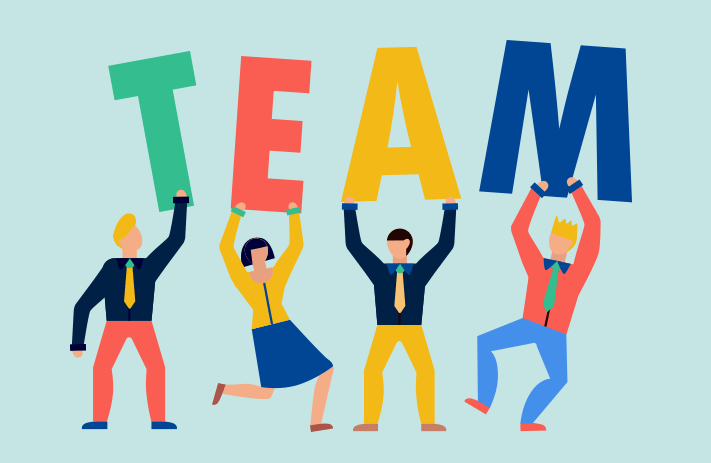
Click the button to start reading
Team Building Activities for Your Business: How to Strengthen Team Bonding With Activities That Create Connection.
Creating a solid team is one of the most essential things you can do for your company. Not only do teams help with productivity and goal attainment, but they also provide social support and can increase morale.
Teams are frequently more productive at completing activities than individuals. However, not all teams thrive. This raises a slew of issues, including:
- What distinguishes a successful group from one that isn’t?
- What are the qualities of a high-performing team?
- What does a journey from an undesirable team dynamic to a positive one look like?
- What activities help foster a sense of teamwork among your employees?
There is no one-size-fits-all answer to these questions, as the makeup and needs of teams vary from company to company. However, there are a few simple things you may do to assist your team and enhance their cohesion.
This blog article will help you grasp what it takes for a group to be successful. You’ll be able to spot the most important milestones by which every team reaches unity. Finally, we’ll provide some simple things that you and your teammates can do to enhance team bonding and collaboration.

WHY TEAMWORK IS IMPORTANT?
The benefits of teamwork are widely known and documented. When teams work together effectively, they can achieve goals that are impossible for individuals to reach. In business, this can mean a lot of things like:
- Increased efficiency
- Enhanced creativity
- Improved communication
- Stronger relationships
All of these benefits add up to one thing: a successful team is more productive than a group of individuals.

WHAT MAKES A HIGH-PERFORMING TEAM?
To create a successful team, you and your employees need to understand what attributes make high-performing teams so effective. Many elements go into making a successful team, but the five most essential ones are trust, cohesion, clear communication, feedback, and celebration.
In this section, we’ll go through each of these components in detail, and we’ll conclude with a discussion on the five phases that teams must pass through to achieve high performance.
5 Attributes of a Thriving Team
1). Trust – trust is the foundation of any relationship, whether it be personal or professional. When team members trust each other, they are more likely to take risks and reveal their ideas and opinions.
Action: Trust can be a difficult thing to build because you can’t directly create it. However, there are a few things you can do to help build trust in your team:
- Be transparent – share information with your team and be open to questions.
- Be consistent – do what you say you’re going to do, and follow through on your promises.
- Be supportive – offer encouragement to team members when they make mistakes or fail.
- Be open and honest with your team members.
- Be positive – trust takes time to build, so avoid criticizing your team or doubting their abilities.
2). Cohesion – cohesiveness is the ability of a team to trust each other, work well together, and be supportive of each other. Cohesive teams have a sense of “we-ness” and feel like they are part of something larger than themselves.
Action: Cohesion can benefit greatly from the team-building activities you’ll learn below, which will enable members of the team to get to know one another better. People are more inclined to trust and cooperate when they realize each other’s quirks and strengths.

3). Clear Communication – Communication is key in any relationship, and it’s especially important in a team setting. When everyone is on the same page, communication flows easily and misunderstandings are minimized.
Action: There are several things you can do to improve communication within your team:
- Hold regular meetings – discuss progress, roadblocks, and other issues in a face-to-face setting. Meet often enough so that communication doesn’t become stale or forgotten.
- Use clear language – be specific when giving instructions or sharing information.
- Set clear goals – make sure everyone knows what the team is trying to achieve.
- Encourage participation – allow everyone to share their ideas and thoughts with the team.
- Avoid distractions – put away your phones, laptops, and other devices to minimize interruptions.
4). Feedback – Feedback is essential for teams moving towards goals. It allows people to understand how they’re doing, identify areas for growth, and learn from their mistakes. In a team setting, feedback should be given and received regularly. This helps team members stay on track and make corrections when necessary.
Action: Some tips for giving effective feedback:
- Be specific – mention the exact behavior or action that you’re addressing.
- Be constructive – focus on how to improve instead of pointing out what’s wrong. Also, use “I” statements versus “you” messages as it allows for more personalization and helps avoid defensiveness.
- Be timely – give feedback as soon as possible after the event has occurred.
- Be aware of your tone – be positive and respectful when giving feedback, even if the message is difficult to hear.

5). Celebrate – Celebrating accomplishments is an important way to show team members that their work is valuable. It also builds morale and strengthens team cohesion.
Action: There are many ways to celebrate successes, big and small. Some ideas include:
- Sharing a meal – get together after a project has been completed or celebrate a holiday with food and drinks.
- Public recognition – create a monthly or quarterly award to celebrate an individual who has gone above and beyond.
- Celebrating milestones – celebrate each major milestone along the way, even if it’s just a small celebration with your team members. The more people celebrate together, the stronger their bond will be!
Now that you know the key qualities of a successful team and what you can do to improve it, it’s time to look at the 5 essential stages that a team goes through, so you can figure out where your team is at any given moment along its path to success.

5 essential stages of team building
The five-stage development process that most teams follow to achieve high performance was first identified by Dr. Bruce Tuckman, an educational psychologist. He referred to the phases as forming, storming, norming, performing, and adjourning.
Understanding his framework can help you identify what kind of activities your teams need at each point in the development process so they’re prepared for whatever comes next.
Forming
In the forming stage, your team members are trying to get to know each other. They are sizing each other up and looking for clues about how they fit into your group. This is a time when your team members might be tentative with their ideas or contributions. You’ll find this is where group members are waiting to see what others think before speaking up.
Storming
The storming stage is when your team starts to come together. This is where conflicts start to arise as your team members clash over their different ideas and ways of doing things.
The storming stage is the most difficult and crucial portion of the process to complete. Team effectiveness might suffer in this period since energy is spent on non-productive activities. But if navigated successfully, your team can move on to the norming stage.
Norming
In the norming stage, your team starts to coalesce into a unit. They develop rules for how they will work together and how they will resolve conflict. This is a time to start building trust and rapport with one another, as well as learning how they all work best together.
Performing
The performing stage is when your team starts humming along efficiently. They are operating like a machine and there isn’t much discord or drama on the team anymore.
Adjourning
In the adjourning stage, most of the team’s objectives have been achieved. The aim is to complete the last activities and document the project and outcomes. The team may also dissolve at this point.
The five stages of team building are important to keep in mind when you are trying to foster cohesion within your team. Not all teams will go through each stage in order, and some might skip a stage or two. But understanding these stages can help you better understand how your team functions and what you can do to improve their performance.
Now that you’ve seen the characteristics of a successful team and know what the road to becoming a high-achieving company entails, It’s time to look at what kinds of things your team might do to foster good relationships and greater cohesion as they work toward a common goal.

4 Types of Team Building Activities
A team development activity is a planned group event that allows your employees to get together and work on the dynamics of their relationships while having fun. There are many types of activities you can choose from, depending on what kind of experience you want them to have.
Admittedly forced workplace activities can be cheesy but the results pay off. According to a study done by Gallop, companies that prioritize their culture and encourage employees to have fun together are more likely to be successful.
Here are 4 types of activities that can help your team achieve growth.
1). Trust Activities
For starters, trust activities are a great way to help your team members get to know each other better. They can help break the ice and encourage people to gel. This can help your team feel more comfortable working together and develop trust faster.
Any activity that requires dependents on team members to complete a task or solve a problem can help facilitate trust.
For example, your team members could be given materials to build something while blindfolded. Or you could blindfold one team member while crossing a balance beam with another team member.
This can result in some hilarious moments, but it will also help your team members to build connections leading towards trust.
2). Team Building Through Competition
Competition is another great way to help your team members bond. It can also be a great motivator, especially if the stakes are high.
When people are competing against one another, they tend to raise their game and work harder. This can lead to better performance in the long run.
There are many different ways you can use competition within your team-building activities.
One way is to have a team competition where the winning team gets a prize. This can be something small, like bragging rights or pizza for lunch, or it could be a bigger prize, like gift cards or an extra day off work.
You could also challenge teams to complete an obstacle course or game that requires them to work together.
For example, you could have a race where teams have to navigate through an obstacle course using only the materials they can find in the room.
Now you need to keep in mind that sometimes things can get too competitive. If this happens, it’s important to have a discussion with your team about why the competition is getting out of hand and how they can work together to fix the issue.
However, even a minor dispute may have significant benefits for your team if handled correctly.

3). Team Building Through Collaboration
In general, collaboration may be defined as two or more people coming together to create a finished good. Collaboration activities can serve as an excellent method for assisting your teammates in building relationships and cooperating.
This works best when the team members have complementary skills and different perspectives, as it allows them to be open-minded and consider what each person brings to the table.
You can create this activity in a variety of ways that can be indirectly or directly related to your business tasks.
If you go down the indirect route, the team could be given a project that’s completely unrelated to their work but still requires them to unite and come up with solutions.
Alternatively, If you chose to go the route of choosing an activitiy directly related to their work, you could have them create a presentation that gives feedback on an existing product, project, or marketing campaign. This will allow your employees to get to know each other better while also improving your business’s products.

4). Communication Exercises
Communication exercises are a great way to help your team members come together. They can help improve communication in the workplace, which is essential for success.
There are many different types of communication exercises that you can use. You could have a meeting where the team has to come up with solutions to a problem without talking. This will force them to communicate more effectively through non-verbal cues.
Another way of doing this is by having a conversation with someone you don’t know very well but are required to answer all their questions as truthfully as possible without any interaction or feedback from them. This can be an extremely difficult task, especially if the other person asks what you think will be difficult questions.
You could also try a communication exercise where the team has to come up with a skit that demonstrates how they would handle a certain situation in the workplace. This will allow them to not only communicate better but also think on their feet.
Whatever communication exercises you choose, make sure that they are appropriate for your team and what you want them to get out of the exercise.
Conclusion
Building a strong team takes time and effort, but it’s well worth it in the end. By using some of the exercises I’ve mentioned, you can help your team come together and work more effectively as a unit. Not only will this improve their morale and productivity, but it will also benefit your business as a whole.
















